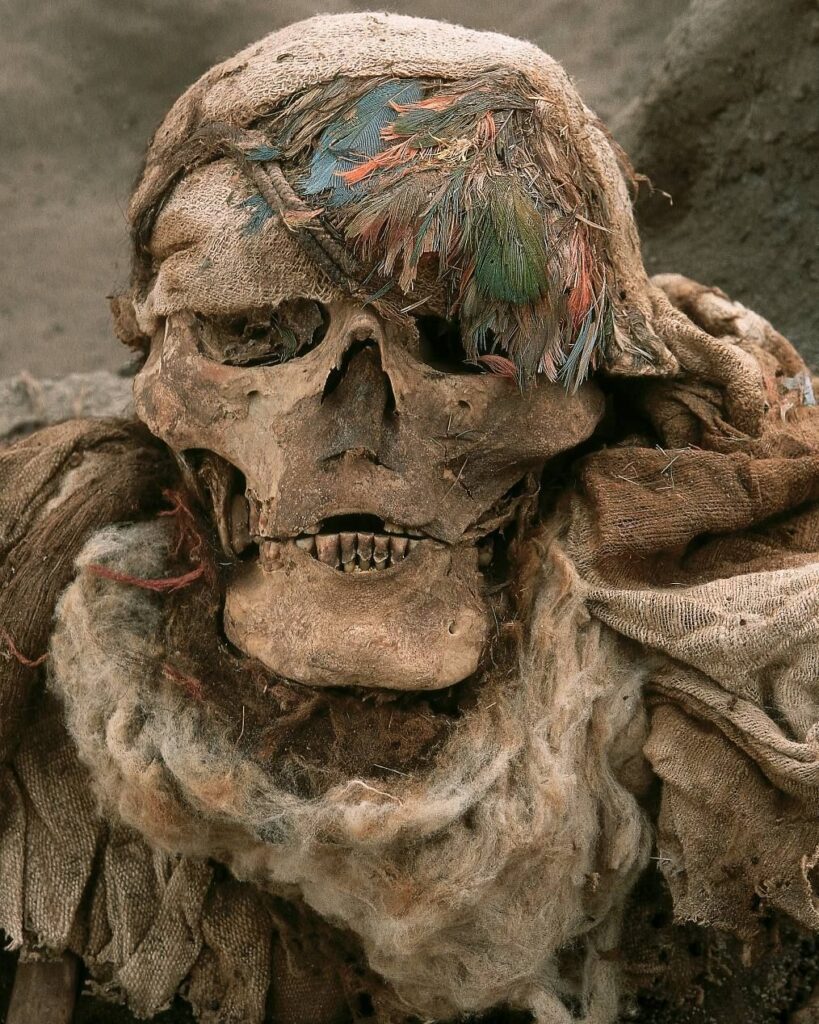500-Year-Old Mummy of an Incan man wearing a feather headdress found near Lima, Peru
Thousands of Inca mummies, some of them bundled together in groups of up to seven, have been unearthed from an ancient cemetery under a shantytown near Lima in Peru.
Believed to be the largest cemetery from one time period excavated in Peru, lead archeologist Guillermo Cock said as many as 10,000 Incas were possibly buried at the site at Puruchuco in Peru’s Rimac Valley between 1480 and 1535.
But Cock, a Peruvian archeologist, said the site was being destroyed at an alarming rate by humans, including the release of thousands of gallons of sewage daily into the shantytown’s streets that had seeped underground and damaged some mummies.
“The consequences of humanity on these burials are terrible,” said Cock, adding that some of the mummies were riddled with worms. “It was not a pretty sight.”
Cock, who estimates they uncovered the remains of between 2,200 and 2,400 Incas, said the cemetery provided a huge scientific sampling of the Inca people from infants to the elderly and from the rich to the very poor.
“We have what in sociological terms, we would call the perfect sample to project presidential elections. Each social class and group and age is proportionally represented,” Cock told a news conference at National Geographic’s Washington headquarters.
“This will give us a unique opportunity to look into the Inca community, study their lives, their health and their culture,” added Cock, who has been doing archeological work in Peru since 1983 and is an adviser to the Peruvian government.
The Incas once ruled a vast swath of South America stretching from Colombia to Chile but Spain’s Francisco Pizarro and his band of 160 treasure hunters, using cannons and horses, brought that empire to a bloody end in 1533.
Some of the “mummy bundles” contained as many as seven people buried along with their possessions and weighed hundreds of pounds. The bundles have yielded amazing discoveries, said Cock, including well-preserved individuals, a copper mask, a war club, hand-painted textiles, and pottery.
The bodies were not embalmed, he said but were mummified by placing them in dry soil packed with textiles that helped them dry out more quickly.
“The process, although natural, was intentional,” he said.
So far, Cock said only three bundles had been unwrapped in what was a painfully slow, expensive process. It would take generations before the full implications of the find were known.
One of the unwrapped bundles, nicknamed the Cotton King, was made up of hundreds of pounds of raw cotton. Inside was the body of an Inca noble and a baby as well as 70 items including food, pottery, animal skins, and corn.
Among the most interesting discoveries was the number of elite members of Inca society, some of whom were still wearing the elaborate feather headdresses they were buried in. Another striking find was 22 intact and 18 disturbed “false heads,” or falsas Cabezas. These are mummy bundles usually reserved for the elite with a bump on top filled with cotton and resembling a human head, many of them with wigs.

These bundles contain several people, one of them the key person and the remainder probably accompanying him in the afterlife. The bodies of adults are in the traditional fetal position, with their possessions arranged around them.
“Prior to our excavations, only one falsas cabezas bundle from the Inca Period had been recovered by an archeologist, in 1956,” said Cock.
Cock said it was unclear whether all of the bodies in these bundles were related but probably when a key person died his body was put aside until the remainder of his party died and could be buried with him.
“Mummy bundles are like time capsules from the Inca,” said Johan Reinhard, explorer-in-residence at the National Geographic Society. “The huge number of mummies from one period of time provides an unparalleled opportunity for new information about the
Incas.”
About 50,000 to 60,000 artifacts were retrieved from the site and 22 of these are on display at National Geographic, including ancient ceramic pots and patterned textiles. Cock and his team worked at a frenetic pace over the past three years to salvage as much as they could from the cemetery before the shantytown was leveled for development.
The site is known as Tupac Amaru by the 1,240 families who sought refuge there from 1989 after fleeing guerrilla fighting in the Peruvian highlands. Aside from the toll, the cemetery has taken from tens of thousands of gallons of liquid being dumped daily into the ground, other graves were destroyed by bulldozers in 1998.
Shantytown dwellers fought to remain on the site and archeologists turned the area into a giant dig, building bridges for people to cross the streets. Some of the residents joined in the dig. Some of the graves were found very close to the surface, especially in a dusty school playground which had been leveled several years ago.





